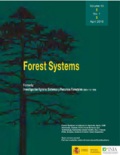Ver ítem
- xmlui.general.dspace_homeCentros Regionales y EEAsCentro Regional Buenos Aires SurEEA BalcarceArtículos científicosxmlui.ArtifactBrowser.ItemViewer.trail
- Inicio
- Centros Regionales y EEAs
- Centro Regional Buenos Aires Sur
- EEA Balcarce
- Artículos científicos
- Ver ítem
Wood density and anatomy of three Eucalyptus species: implications for hydraulic conductivity
Resumen
Aim of the study: To characterize wood anatomical traits of three Eucalyptus species that differ in wood density and ecological requirements, and to examine the relationships between some anatomical features, wood density, and theoretical xylem hydraulic conductivity (Ks).
Area of study: We analyzed 86 trees from three sites of Argentina (Entre Ríos and Buenos Aires Provinces).
Methods: The sampled trees were Eucalyptus globulus, E. grandis and E.
[ver mas...]
Aim of the study: To characterize wood anatomical traits of three Eucalyptus species that differ in wood density and ecological requirements, and to examine the relationships between some anatomical features, wood density, and theoretical xylem hydraulic conductivity (Ks).
Area of study: We analyzed 86 trees from three sites of Argentina (Entre Ríos and Buenos Aires Provinces).
Methods: The sampled trees were Eucalyptus globulus, E. grandis and E. viminalis ranging from 11 to 15 years old. One stem disc was cut from each tree to determine wood density and identify quantitative anatomical features of vessels and fibers. Vessel composition (S, size - to-number ratio, a measure of vessel size distribution) and lumen fraction (F, the total sapwood area available for water transport) were estimated.
Results: E. grandis, the species with the highest growth rates, presented the highest theoretical Ks. This was associated with anatomical features such as a high density of wide vessels resulting in high F. On the other hand, E. viminalis, the species with the lowest growth rates and highest resistance to environmental stress, showed lower Ks as a result of a low density of wide vessels. These two species differed not only greatly in wood density but also in fiber characteristics. In the case of E. globulus, vessels were relatively narrow, which resulted in the lowest theoretical Ks, fibers were small, and wood density intermediate.
Research highlights: F had greater influence on Ks than S. The anatomical characteristics and wood density could only partly explain the differential growth or resistance to stress of the studied species.
[Cerrar]

Autor
Barotto, Antonio José;
Monteoliva, Silvia;
Gyenge, Javier Enrique;
Martinez Meier, Alejandro;
Moreno, Karen;
Teson, Natalia;
Fernandez, María Elena;
Fuente
Forest Systems 26 (1) : e010 (2017)
Fecha
2017
ISSN
2171-9845 (Online)
2171-5068 (Print)
2171-5068 (Print)
Formato
pdf
Tipo de documento
artículo
Palabras Claves
Derechos de acceso
Abierto
 Excepto donde se diga explicitamente, este item se publica bajo la siguiente descripción: Creative Commons Attribution-NonCommercial-ShareAlike 2.5 Unported (CC BY-NC-SA 2.5)
Excepto donde se diga explicitamente, este item se publica bajo la siguiente descripción: Creative Commons Attribution-NonCommercial-ShareAlike 2.5 Unported (CC BY-NC-SA 2.5)


